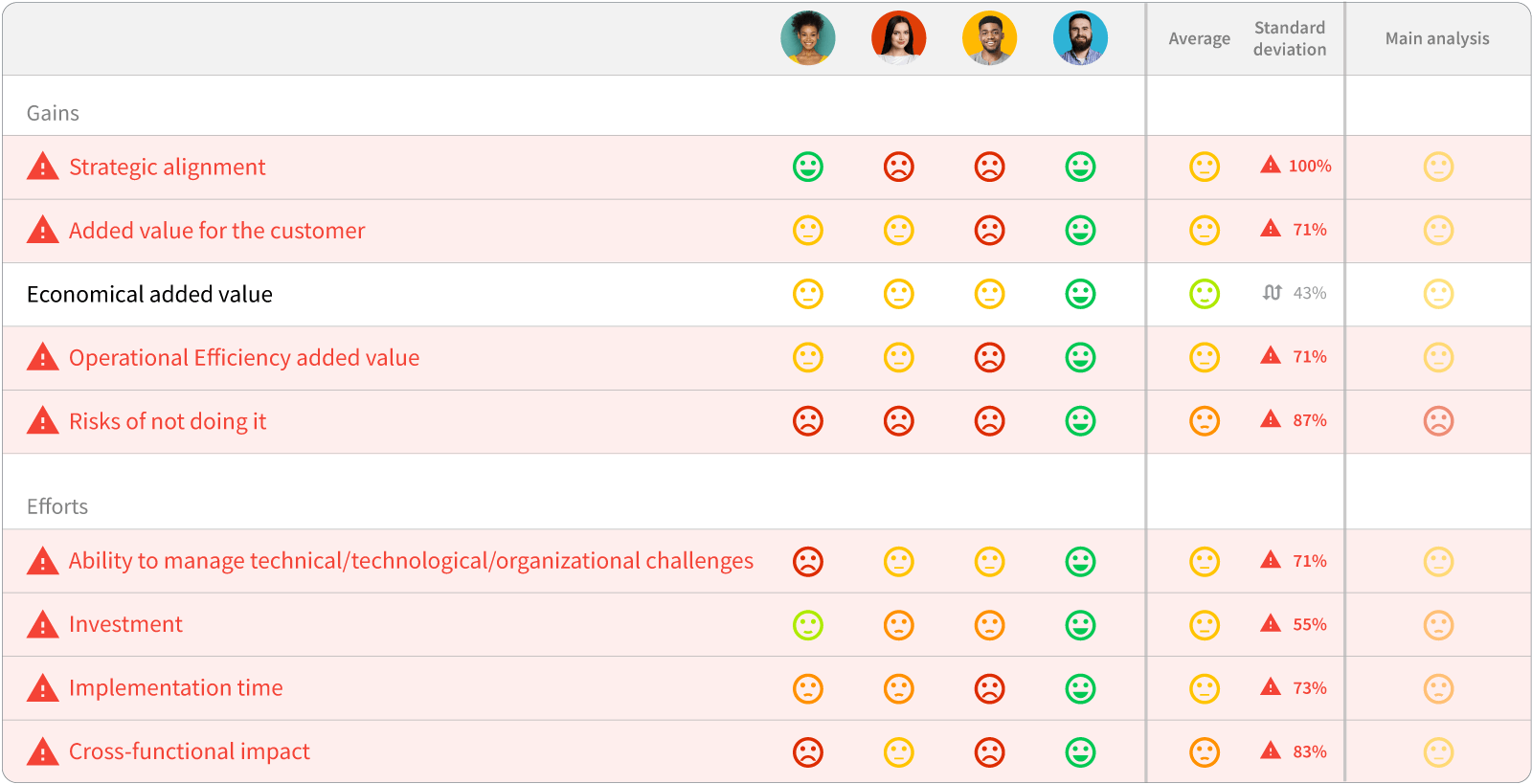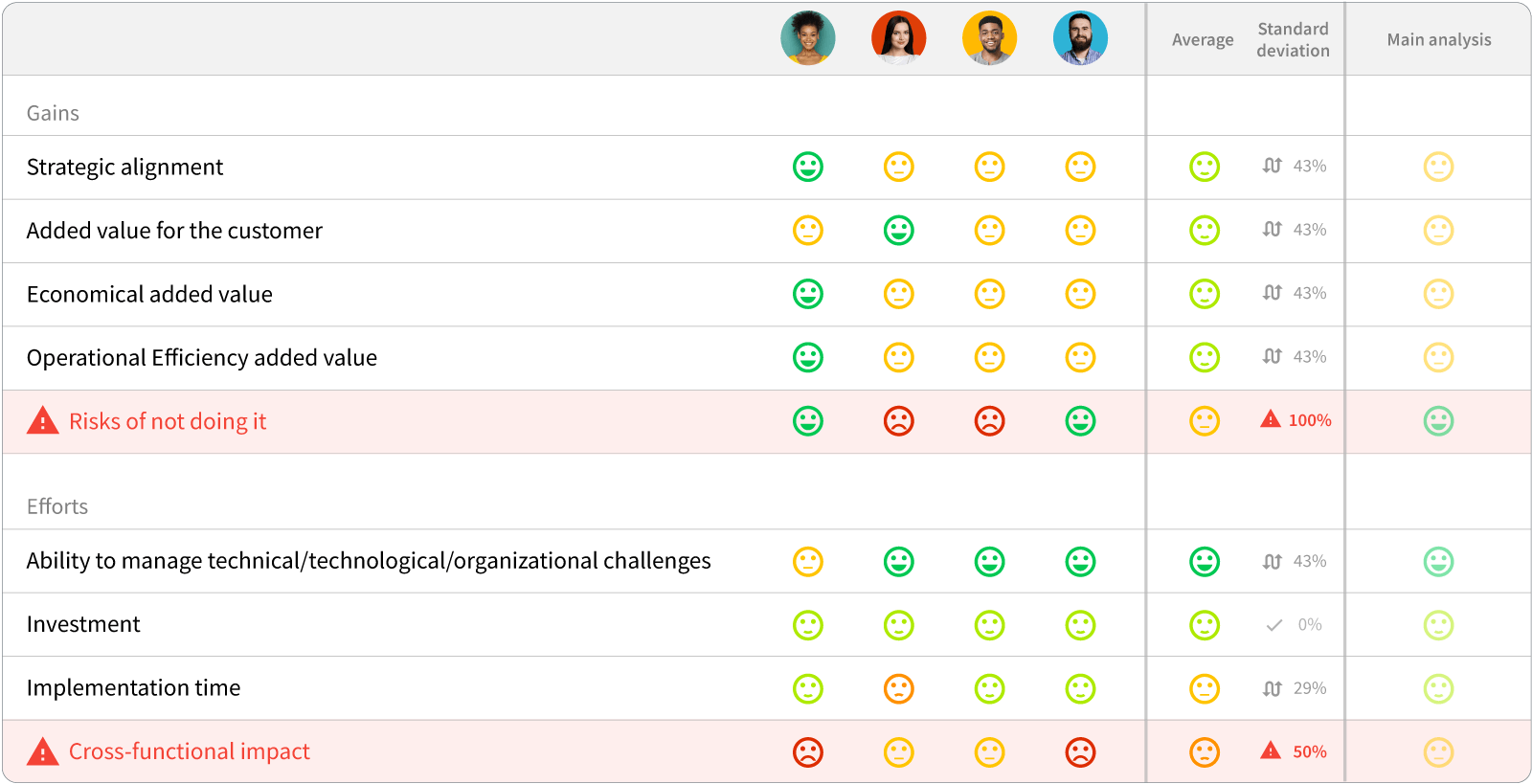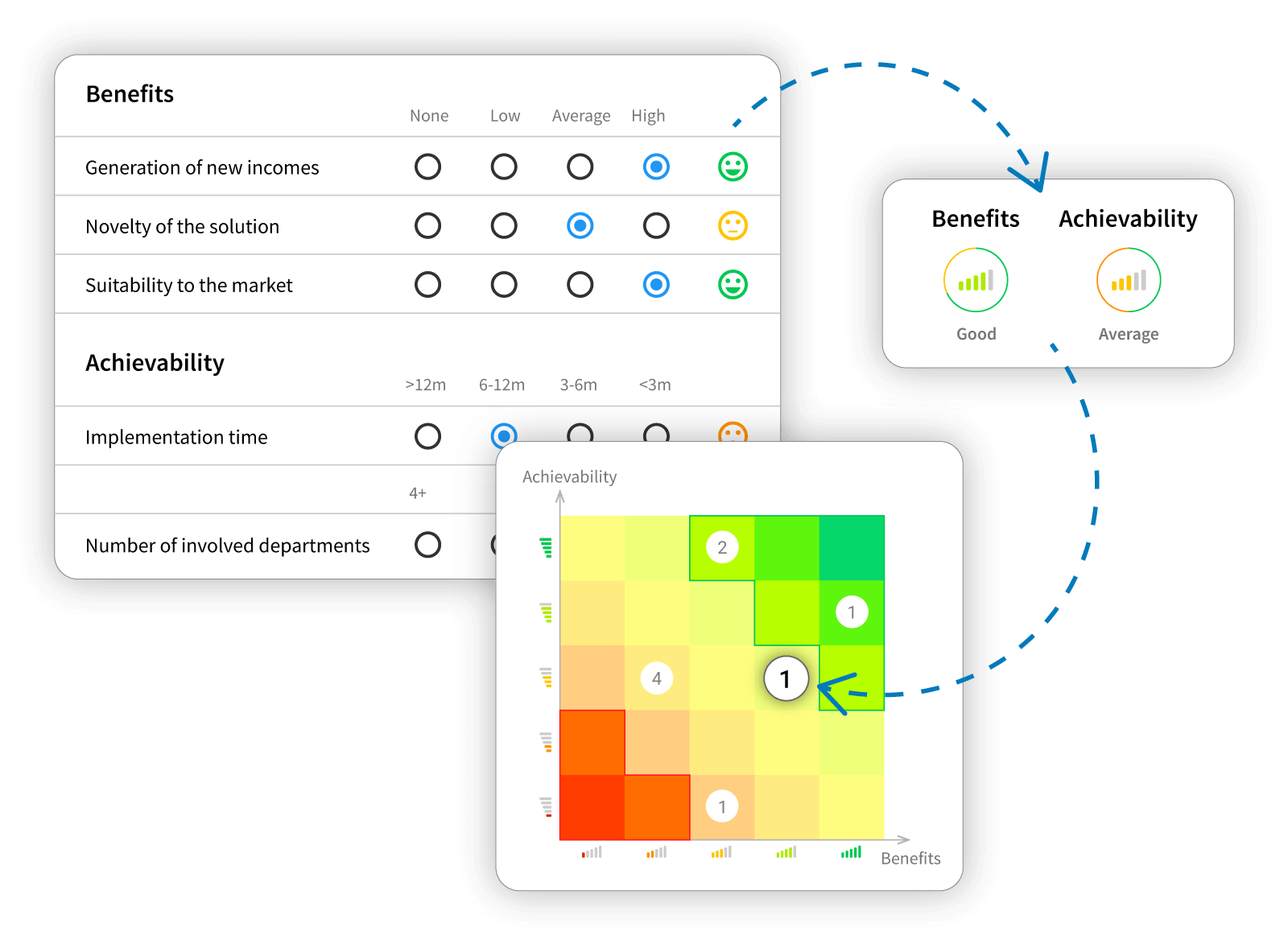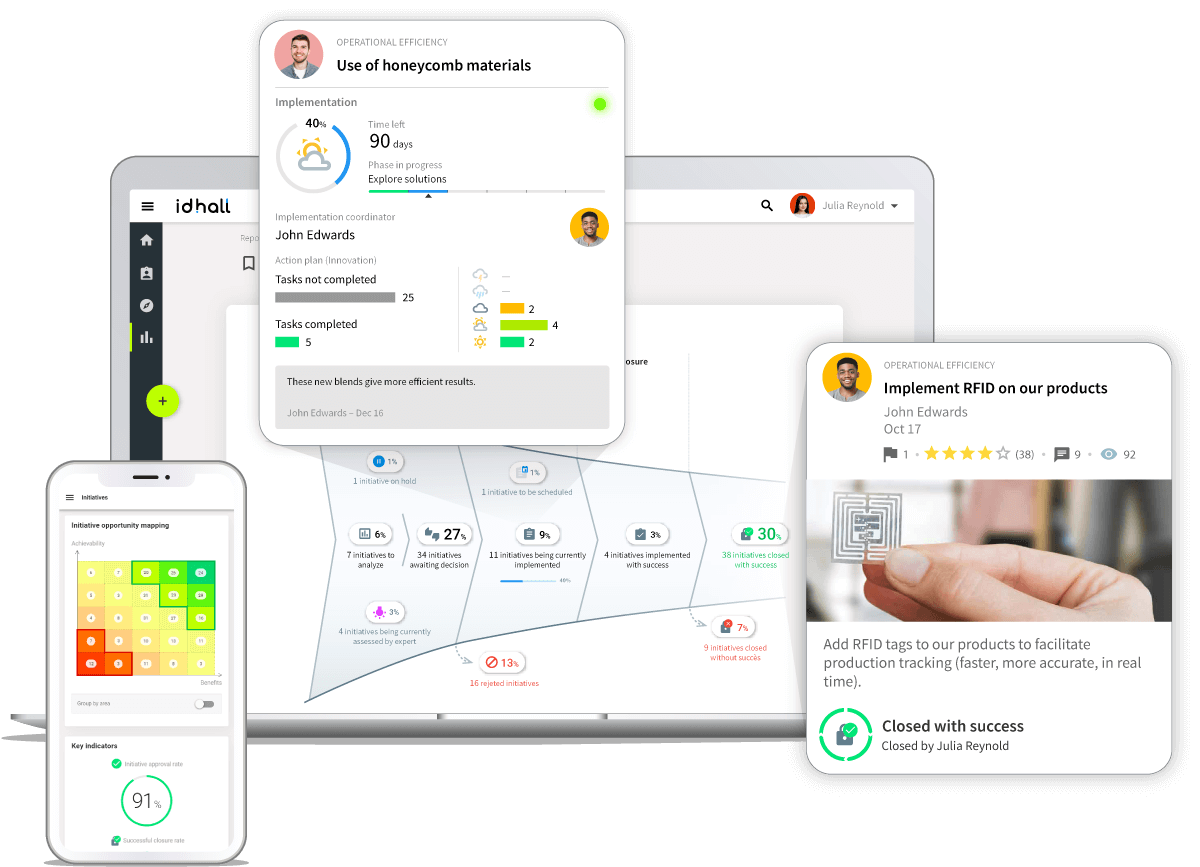In successful companies, ideas, projects and action plans abound. So many initiatives can be a heavy burden for operational staff. You assign a manager, set a deadline for each action and you’re done. Then you arrange it all in an Excel spreadsheet.
Missed deadlines stack up, the spreadsheet turns red, teams disengage, and good intentions dwindle.
The company refocuses on strategic, top-down projects while bottom-up, participative, collaborative projects – what truly drives an organisation – sink.
This can all be avoided with opportunity analysis.
Defining opportunity analysis
An opportunity analysis is also known as an opportunity study, opportunity score, or business case. These terms all mean the same thing: an objective way to assess the merit of an initiative or project.
Should the company: Open a new subsidiary? Open up to new markets or geographical regions? Adopt new technologies to boost productivity?
Company strategy can be multi-stranded and it’s important to assess different options to ensure the organization grows in line with its situation.
Business cases, or opportunity analyses, need defined criteria that assess a project’s potential wins against the effort required for implementation. Scoring initiatives in the same analysis grid helps you to compare and prioritize.
In practice, the score is determined upstream, pre-project, with all the data necessary for analysis. It can be monitored closely throughout the project cycle if it has been approved and prioritized.
In short, opportunity analysis helps companies avoid viewing ideas and projects through the wrong end of the telescope.
Opportunity analysis v feasibility study: what’s the difference?
An opportunity analysis is not just a feasibility study. It’s a feasibility study (i.e. is the initiative achievable?) combined with an evaluation of the expected results. It provides an effort/reward ratio and ranks initiatives according to both potential gains and the company’s ability to implement them.
Why conduct an opportunity analysis?
Without an opportunity analysis, action plans are launched on the hoof without any collective appreciation of the challenges, risks, and implications. Priority is determined randomly based on the calendar, random convictions or…incantations.
Lack of nuance between projects strips the organization of essential capabilities to:
- Decide against launching certain projects;
- Seize opportunities for quick wins;
- Prepare for complex projects.
Opportunity analysis is essential for analysing situations and taking the best decisions for potential projects. It ensures the organization’s development plan is a success by selecting the most relevant initiatives for the company’s needs and objectives.
Advantages gained and risks avoided
A business case identifies the advantages of an initiative and the risks of not going ahead with it. Gain perspective on a solution’s sustainability (long-term usefulness) and its impact on employee engagement (improving working environment and conditions).
Driving projects to fruition means mobilizing all the stakeholders, especially employees. Ideas, projects, and action plans are part of a collective approach within complex organizations. Improving, transforming, and innovating is no mean feat: you must rally the troops! Exclusively top-down systems quickly show their weaknesses for successfully implementing a project: realities on the ground are ignored and teams disengage.
Opportunity analysis is an exhaustive way to raise collective awareness of a project’s benefit compared with others. No more in-fighting. Avoid “He who shouts loudest” getting their own way. And escape “Not invented here” syndrome that is well known in business.
Establish a business case
Evaluating anticipated results helps to measure an initiative’s potential wins according to different criteria. It’s standard to have between three and ten criteria and they may apply to a specific portfolio of initiatives.
Evaluating feasibility lets you measure the organization’s capacity to implement the initiative and achieve the expected results. The criteria are often common to the whole organization.
Evaluating different criteria combined with the initiative description gives a score or an opportunity scorecard.
Business cases are sorted into four categories:
- Low reward/high effort: Complex, risky initiatives for little expected gain – nothing to win and everything to lose. Cut these initiatives loose.
- Low reward/low effort: Easy to implement but not much to gain – deal with these when there’s not much else on.
- High effort/high reward: Complex and risky with high potential wins. Tread carefully and methodically to mitigate risk.
- High reward/low effort: Easy to implement with potential for big wins. Go for it. Otherwise known as low-hanging fruits.
Key criteria for opportunity analysis
As mentioned above, an opportunity analysis is not just a feasibility study because it aims to assess potential value creation for an organization. However, an upstream feasibility study identifies potential constraints and challenges that the proposed project may trigger. This also helps to refine the opportunity analysis.
Here are some criteria to consider in your feasibility study:
- Technical, technological, and organizational challenges: Consider the technical constraints and available resources, knowledge of the technologies involved, and the ability to use them efficiently to reach targets.
- Investment and costs: Make sure the company has the financial resources to see the project through successfully.
- Implementation time frame: The longer the project drags on, the harder it is to keep teams engaged and available.
- Cross-functional buy-in: Implementing a project may involve different stakeholders, such as technical, sales, and support teams. The more departments involved, the more dependant you are on other entities.
Once the feasibility study is complete, simply correlate with the expected results.
Assessment criteria may vary depending on the aim, feasibility, sector, market, and stakeholders involved. Nevertheless, here are some results criteria common to most companies:
- Alignment with company strategy;
- Added value for customers;
- Added value for employees;
- Economic impact;
- QHSE impact (quality, health, safety and environment) or CSR (corporate social responsibility);
- Impact on brand image and reputation;
- Unique character, opportunity to stand out in a market place.
Once you’ve established the list of essentials, the challenge lies in defining units of measurement for each criterion to rate them objectively.
Use this template to ensure successful projects
It’s important to proceed in stages when building a business case. Two key stages in the template are employee engagement and managing opportunity scores effectively.
Involve employees from the planning stage
Faced with stagnating projects and overloaded teams, companies are tempted to see a performance problem or resource management issue. More often than not, analysis and prioritizing are the culprits.
When the temptation to micro-manage rears its head, it’s time to spread a culture of opportunity analysis.
People need to quickly learn how to spend time on the decision-making process to gain volumes more/optimise the execution process. When moving toward this, bear in mind: “If I’m involved in decision-making, I’m involved in performance.” (Read how Olivier Zara explains the concept in terms of decision-making excellence).
Involving relevant employees in opportunity analysis helps understand everyone’s point of view based on an objective and exhaustive list of criteria. Creating constructive dialogue between stakeholders prevents misunderstandings that could prove fatal when it comes to implementation.


Manage opportunity scores with a project approval committee
Companies are catching on and introducing project approval committees. It’s their job to prioritize, then allocate resources. This prevents all the projects being launched at once.
The chance of success is optimized by dealing with the issues in hand instead of multiplying them. Launching too many initiatives at once overloads schedules which ultimately delays delivery. Remember the queuing theory, also known as Little’s Law? Read about it here.
Armed with opportunity scores and analysis, project approval committees concentrate on low-hanging fruit and make them a priority. When it comes to the most promising initiatives that require substantial effort, project approval committees must involve everyone expected to do the grunt work.
The indicators go from red to green. We win team commitment to transformation, innovation and continuous improvement.
Produce an opportunity score
There are various ways to produce an opportunity score. However, if you want to compare initiatives effectively without them raining down on teams like a meteor shower, use suitable project management software.
Microsoft Project and Excel are not the only options. IDhall is a collaborative solution offering a unique overview of all the opportunities, helping you to prioritize and decide which initiatives to implement.
Download our e-book for all the best practices to drive your action plans forward:

This article was originally published on March 23, 2022 and was updated on April 19, 2023.






